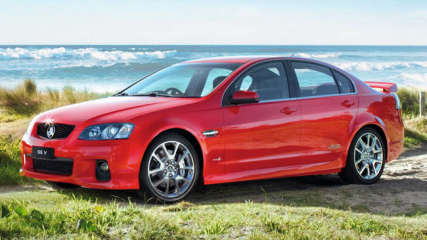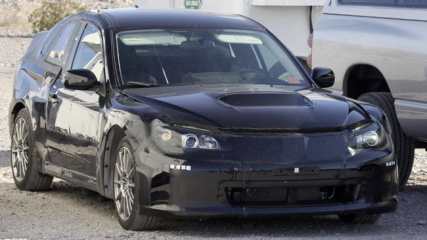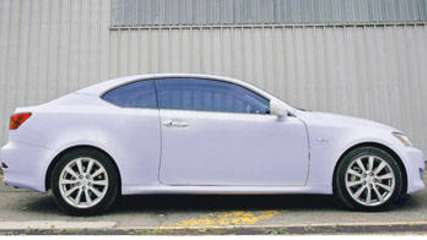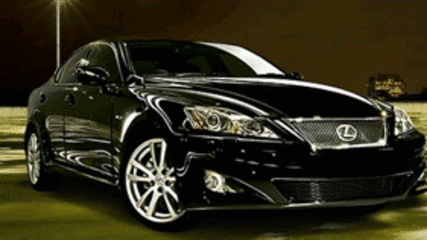Lexus IS F 2011 News

V8 cars are special
Read the article
By Mark Hinchliffe · 14 Jul 2011
Even at a time when fuel economy is top-of-mind with a growing number of Australian drivers there is plenty of space on the roads for Commodores and Falcons with old-fashioned V8 muscle under the bonnet. They burble menacingly at idle. They are the backbone of V8 Supercar racing.Yet V8s in the 21st century are not what they were in the days when they first conquered Mount Panorama and a GTHO Falcon or a Monaro - or even a Valiant V8 - was a dream machine for a generation of Aussie youngsters.Since 1970 the crude oil price has exploded from $20 a barrel to double that amount during the Iran revolution, over $70 during the first Gulf War, broke through the $100 barrier ahead of the Global Financial Crisis and has now settled at just below $100.In Australia, petrol prices have correspondingly risen from about 8c a litre in 1970 to about 50c in 1984 and almost $1.50 today.Despite all this, and despite one attempt at a death sentence by Ford in the 1980s, the V8 has not been wiped from Australian showrooms. Holden and Ford have continued to produce large cars with a V8 alternative and continue to slog it out at Bathurst.But Australian cars, even the ones that now have American V8s imported for local use, are not the only bent-eight blasters on the road.Germans are prolific builders of V8s and produce some of the most powerful engines in the world thanks to AMG-Mercedes, BMW and Audi. English V8s are built by Aston Martin, Land Rover and Jaguar, while the Americans provide V8s in the Chrysler 300C sold here. Even the Japanese luxury brand Lexus has a V8 in its IS F hero and its luxury saloon LS460, as well as the LandCruiser-cloned LX470.Most V8s are powerful enough breathing ordinary air, but there are many forced-induction models with either turbo or supercharging to liberate even more power. Walkinshaw Performance does the job in Australia for Holden, BMW is going down the turbo V8 road for its latest M cars and Benz had a time with a supercharged AMG V8.But V8s are not just about unrestricted power. The push for greater fuel economy has also reached V8 land and so Chrysler and Holden have V8s with multiple displacement technology which shuts down half the cylinders when the car is just cruising to improve fuel economy. Formula One racing engines now do the same thing when they are idling on a grand prix starting grid.Holden's Active Fuel Management (AFM) was introduced on the V8 Commodore and Caprice in 2008 and the red lion brand is committed to the engine - with future technology updates - despite near-record fuel prices."It is incumbent on us to keep it relevant and continue introducing new technology that delivers on our customers' needs," says Holden's Shayna Welsh.Holden has the biggest stake in V8s with more models than any other company selling in Australia. It has a total of 12 models with V8 engines across four nameplates and four body styles, including Commodore SS, SS V, Calais V, Caprice V and the recently introduced Redline range. V8s account for about one quarter of Commodore sedan sales and almost half of Ute sales."We see it as being more than just the V8 engine - it's about the entire car. It's the whole performance package that appeals to people and we want to continue making cars that people are proud to own," Welsh says."The combination of features and technology, great handling and braking and outstanding value is consistent across our V8 model range."Ford fans are also committed to V8s, according to company spokesperson Sinead McAlary, who says a recent Facebook survey was overwhelmingly positive."We asked whether they worry about petrol prices and they say 'No, it's the sound of the V8 we love and we are prepared to pay the price'," she says.Both Ford and Holden also have performance divisions where the V8 was, and still is, king. Ford's is Ford Performance Vehicles (FPV) and Holden's is Holden Special Vehicles (HSV).HSV marketing manager Tim Jackson says their sales are "on par" with last year."That's despite the fact that last year we had the limited edition GX-P which is an entry level product for us," he says. "We don't have that model in our range at all this year and you would expect numbers to come off, but we've been able to maintain sales volume."All of HSV's range are powered by a naturally aspirated V8 engine (6200cc 317kW-325kW), while the opposition at FPV has gained the kilowatt advantage with forced induction (supercharged 5000cc 315kW-335kW).Jackson says their LS3 V8 has been "validated" by customers."We're not getting guys screaming at us to go turbocharging. The LS3 is an extraordinary unit. It's a light engine with a good power-to-weight figure. There is not a turbo engine that would do it for us at the right development cost. But I wouldn't rule it (turbo) out or rule it in."Jackson says there have been no repercussions from the rise in petrol prices."Our customers don't have other choices in their repertoire," he says. "A small car doesn't suit them and they're not into an SUV. They're of a certain level where the whole cost of running the car is easy for them to absorb."The top-selling HSV is the ClubSport R8, followed by the Maloo R8, then GTS.However, the greatest HSV in history is debatable, Jackson says.HSV engineering boss Joel Stoddart prefers the all-wheel-drive Coupe4 and sales boss Darren Bowler the SV5000."The Coupe4 is special because of its engineering but I like the W427 because it's the fastest," Jackson says.FPV boss Rod Barrett says they are also experiencing strong sales growth. He says they sold about 500 cars in the first quarter, which is up 32 per cent on the previous year. He also says sales of the F6 have slowed since the launch of the supercharged V8 engine variants late last year, as customers "opt for power". Ford no longer offers a V8 with the demise of the XR8 sedan and ute last year."Our middle name is performance so we have all the V8s," Barrett says. "When we were launching this new supercharged car all the V8s came across here."Barrett says their supercharged engine has changed people's minds about "dinosaur V8s"."The turbocharged F6 was a cult hero car in its day and people thought a V8 was a low-tech dinosaur," he says. "But when we produced a high-tech all-alloy five-litre supercharged V8 built in Australia people started to think that V8s aren't all that bad after all. I'm not seeing the demise of the V8 just yet, but for us, the future is hi-tech."The supercharged 5.0Litre V8 335kW FPV GT continues to be FPV's top-selling vehicle followed closely by the supercharged V8 5.0 litre 315kW GS sedan and GS ute.Barrett believes the current GT is the best FPV car yet with its segment-leading power, light weight and improved fuel economy."However, I think our most iconic car was the 2007 BF Mk II 302kW Cobra in white with blue stripes. That car brought back the passion of '78 with the original Cobra. If you have a look at the second-hand prices, they are still holding up very well" he says.

Tokyo Auto Salon
Read the article
By Peter Lyon · 21 Jan 2010
They range from a tiny supercharged Toyota iQ to a full-race Lexus LFA and deliver on the recent promise by Akio Toyoda, the new chief executive of the Toyota Motor Corporation, to inject excitement, passion and driving enjoyment into the world's biggest brand.The most important car is a turbocharged version of Toyota's FT-86, which shows the potential of the production car that Toyoda plans to use to bring young people back to his brand. There is no sign of a hotrod Camry at the show, the third-biggest 'tuner' event in the world after SEMA in the USA and Essen in Europe, but Toyota's introduction of its hero cars creates the biggest surprise since the start of the Global Financial Crisis. The Salon line-up is also a massive contrast to the conservative and underwhelming effort by Toyota at last year's Tokyo Motor Show, traditionally Japan's biggest motoring event.At the Auto Salon, Akio Toyoda does the introductions himself and spends more than 30 minutes talking about the cars during a presentation that partly erases some of the pain of the company's withdrawal last year from Formula One racing. Toyoda said simply ‘We quit’ at the F1 press conference, but also promised cars ‘that generate fun and passion’.The first of the passion pack is unveiled at the Salon and, despite a couple of aero-tweaked Prius sitting on the same stand in a nod to Toyota's hybrid drive, there is plenty of good news. The FT-86 concept has pumped-out bodywork and a powered-up turbo engine, proving the tuner potential in a car that will be in showrooms in 2011. It's a classic rear-wheel drive coupe, just like the original Corolla Sprinter that has become a drift favourite around the world.The rich mix of raunchy metal actually starts with a supercharged iQ GRMN concept produced by Toyota's current tuner favourite, a company called Gazoo Racing Master of Nurburgring. It's still a tiny three-seater but it's quick. There is also a 1.5 litre rear-drive Aigo that has been switched from front-drive, a 325 kiloWatt high-performance Lexus IS-F Circuit Club Sports and a full a race-specification LFA.The big surprise is a car called the GRMN Sports Hybrid Concept, also produced by Gazoo. This two-seater, four-wheel drive hyrid sports coupe is based on the old Toyota MR-2 and boasts a mid-mounted 3.3-litre V6 engine and the company's well-known THSII hybrid system, a delicious combination that generates over 400 kiloWatts.Draped in a carbon fibre body and tipping the scales at around 1500 kilograms, against a final target in the 1300 range, the V6 drives the rear wheels while the electric motor propels the fronts. It can drive in silent EV mode in the city and, when called upon for some quick acceleration, the V6 springs to life and engages the rear rubber.This combination could very well put Honda's CR-Z to shame, even if Honda is calling its new coupe "The world's first hybrid sports car". Stories leaking out of Honda say the CR-Z has only lukewarm performance, unlike the MR-S hybrid that has near-supercar performance and reportedly sprints from 0-100km/h in under 4.5 seconds.So, what's the bottom line from the Tokyo Salon? Based on what Toyota unveiled, it intends to make good on its passion promise and create cars that people really will want to buy.
W.jpg)
Toyota boss to race the Ring
Read the article
By Paul Gover · 22 Apr 2009
The man credited with leading development of the breakthrough Lexus IS-F - which was built to challenge the benchmark BMW M3 - is also pushing hard to get the Lexus LF-A into production.Toyoda is even doing testing on the 300km/h supercar himself.But the 52-year-old grandson of Toyota's founder, who will become the CEO and president of the world's largest car company later this year, is not just grinding around a proving ground.Toyoda is racing an LF-A.The entry list for this year's classic Nurburgring 24-Hour race includes a driver called 'Morizo' in one of the two LF-As to be fielded by the Japanese GAZOO Racing team on May 23-24.But Morizo is actually Toyoda.That means the Nurburgring entry is a very big deal, right down to the bodyguards who will accompany Morizo-Toyoda through the event.Toyoda has used the fake name twice before to race on the full Nurburgring north course, although last year his stealth fighter-black LF-A was one of the first cars to strike trouble in the 24-hour race.This time around the LF-A entry is bigger and official, and there will also be an IS-F in the GAZOO team.Toyoda is one of four drivers in his car and will share with Andre Lotterer, a one-time Jaguar F1 test driver who also leads Toyota's effort in the Japanese SuperGT championship.Morizo's official profile gives a Japlish twist on what Toyoda is doing, and why:"He is a well-known driver at GAZOO Racing. He grips the steering with the great wish to increase car fan and inform fun of run. He participate in Nurburgring continue Year 2007 and Year 2008."

Lexus dreaming of the F world
Read the article
By Kevin Hepworth · 05 Sep 2008
The future for Lexus could be sprinkled with high-performance models as its F label becomes as important as an M badge at BMW.
The chief engineer of the brand's breakthrough IS-F, Yukihiko Yaguchi, is already checking everything from the GS sedan to the RX soft-roaders for their potential for an F upgrade.
He wants more and to do more, even if there is no firm plan.
“It hasn't been decided yet but, yes, I would like to do that,” Yaguchi says at the Australian press preview drive of the IS-F at Fuji Speedway in Japan.
“It is just an idea . . . but the IS F was just an idea, also.”
Yaguchi made the $150,000 IS-F a personal campaign, battling management reluctance and limited support to produce a 5.0-litre V8 competitor for long-standing luxury performance vehicles from BMW, Mercedes-Benz and Audi.
“I wanted to develop a new breed of animal for Lexus,” Yaguchi says.
“In general our company produces rather rational cars and it was certainly a very difficult project . . . I cannot say what the future holds.”
Lexus Australia boss John Roca hopes Yaguchi's IS-F will not be a one-shot wonder.
“There is nothing on the drawing board at this stage, but you certainly wouldn't rule out similar performance derivatives of GS and LS in the future,” Roca says.
“This (car) will also give our existing customers a boost. As much as we have had potential customers wanting to buy a Lexus had this type of vehicle been available, we also have existing customers who have clearly shown they are ready to move into a car of this type.”

Lexus F for fired up
Read the article
By Paul Pottinger · 06 Oct 2007
Then there's this - the IS F.
If Godzilla wore a business suit, this is very likely the car he’d drive to work. The first in a series of specialised “F” cars for Lexus, it’s Japan's answer to Germany's high-performance V8 mid-sizers such as BMW's M3 and Audi’s RS4.
Carsguide was given a preview ahead of its appearance at the Australian International Motor Show on Thursday.
The Lexus is the first ultra-fast sports sedan from Toyota's luxury division.
An apparently 5.0-litre V8 has been shoehorned into an engine bay that normally hosts a powerplant of half that capacity, driven through the world's first eight-speed direct sport shift gearbox and the rear wheels.
In order to be competitive with the usual suspects, the F car needed to achieve the 0-100km/h sprint in less than five seconds – 4.9, which is their precise claim. Lexus product planning manager Jeff Shafer relates preliminary specifications of “more than 300kW and more than 470Nm” to move its approximately 1.7 tonne kerb weight, distributed 54:46 per cent front-to-rear.
As to the nomenclature, the “F” code signifies those special vehicles that are removed from the Lexus engineering and development mainstream. And, as it happens, much of the IS F development took place under Yukihiko Yaguchi at Fuji Speedway at the foot of Mt Fuji, an aptly volcanic backdrop for the car in question.
Shafer is one of the chosen few to have driven the near-production IS F.
While he says that Mr Yaguchi was “adamant that the IS F had to have the instant sensory elements of driving” it also needed to be sufficiently civilised to be a daily driver.
In both respect, Shafer says the IS F is well-served by its all-new eight-speed Direct Sport-shift Transmission (DSS).
A new torque-converter lock-up control was developed that allows for a direct, crisp gear change through the constant lock-up of the torque converter in second through eighth gear. In Drive mode, the transmission is skewed toward smoothness, and the torque converter allows for enhanced launch capability.
For more frenetic deployment, manual mode allows fingertip shifting via the steering wheel-mounted paddles - the fastest changing of its type, Shafer says. Downshifts are accompanied by automated and precise throttle blips to match engine RPM to vehicle speed.
Unlike the current and conventional IS, the Drive mode can be temporarily overridden by the paddles without engaging manual mode. So you can engine brake into a corner in your chosen cog and allow the torque converter to take over as you emerge.
A smarter-than-ever Vehicle Dynamic Integrated Management System (VDIM) manages power delivery, braking response and suspension settings, all of which are changeable at the push of a button. Indeed, this newest VDIM has three modes, with the Sport mode providing what Shafer says is greater latitude before the electronic safety measure intervenes.
Of course you can simply switch the thing off altogether and go your hardest, so it’s a good thing that this is underwritten by purpose-specced Brembo brakes.
The standard wheels are custom 19-inch forged-alloy BBS number shod with 225/40R19s at the front and 255/35R19 for the rear. Of course, the F rides on a dropped and tightened suspension.
These are also the subtlest visual hints the F is a departure. Other exterior pointers run to a bonnet that bulges to accommodate the bigger engine, a bespoke body kit and quad exhaust pipes.
The interior is similarly understated but striking with aluminium composite trim, special surface treatments and F logo on the steering wheel and rear-centre console. The most obvious departure from the norm is that the F seats four not five, albeit in cosseting and supportive sport buckets.
No doubt some will find the visual cues insufficiently bling, but anything more overt would be at odds with the executive express segment at which Lexus are aiming.
The metallic blue of the car we were shown is the range’s signature colour, one that is intended to suggest a “flame when it gets to 1500 degrees”.
On the face of it, the IS F will be hot enough for the Germans to feel the heat.
See this car at the Australian International Motor Show

Lexus racing to the hot rod league
Read the article
By Stuart Innes · 13 Jul 2007
Other brands before it have taken on a sideline of “hero car” models where sports looks and high performance earn the brand extra status.
Lexus can make this move with justification: Lexus cars do race in various categories overseas, including at the famed Japan Fuji Speedway. And it's that first letter, F, that will mark the Lexus premium performance vehicles.
First car in Australia, in about a year, will be the IS-F based on the existing compact IS250 which now has a 2.5-litre V6 engine delivering 153kW of power.
The IS-F hot version will be aimed at European performance sedans.
There's even talk of it running a five-litre V8 of 300kW, an eight-speed transmission (from the LS460 flagship saloon, perhaps) and limited slip differential to get better power to the ground. Lexus Australia manager John Roca says the IS-F signals the expansion of the Lexus range outside its traditional luxury-vehicle segment.
“This IS-F is the embodiment of performance,” he says. “Just by looking at the vehicle, you know that it is something special. It will be the ultimate in performance cars and Lexus's first performance-specific model.”
Lexus sister brand Toyota is about to release its performance version here, the TRD Aurion - the V6 has been supercharged to give a predicted 235kW of power.
Holden performance arm HSV is doing well in sales while Ford has its Ford Performance Vehicles (FPV) and Mitsubishi is preparing a supercharged 380 V6, with 230kW of power being suggested.




